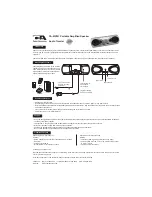
Preparing for Use
R&S
®
SMC100A
19
Quick Start Guide 1411.4077.62 ─ 07
Risk of electrostatic discharge (ESD)
Electrostatic discharge (ESD) can damage the electronic components of the instrument
and the device under test (DUT). ESD is most likely to occur when you connect or dis-
connect a DUT or test fixture to the instrument's test ports. To prevent ESD, use a wrist
strap and cord and connect yourself to the ground, or use a conductive floor mat and
heel strap combination.
For details, refer to the basic safety instructions delivered as a printed brochure with
the instrument.
Risk of instrument damage during operation
An unsuitable operating site or test setup can damage the instrument and connected
devices. Ensure the following operating conditions before you switch on the instrument:
●
All fan openings are unobstructed and the airflow perforations are unimpeded. The
minimum distance from the wall is 10
cm.
●
The instrument is dry and shows no sign of condensation.
●
The instrument is positioned as described in the following sections.
●
The ambient temperature does not exceed the range specified in the data sheet.
●
Signal levels at the input connectors are all within the specified ranges.
●
Signal outputs are correctly connected and are not overloaded.
2.3.1 EMI Suppression
Electromagnetic interference (EMI) may affect the measurement results.
To suppress generated Electromagnetic Interference (EMI),
●
Use suitable shielded cables of high quality. For example use double-shielded RF
and LAN cables.
Note:
USB cables are of varying and often poor quality. Therefore, check the qual-
ity of each individual USB cable as described in the service manual.
●
Always terminate open cable ends.
●
Note the EMC classification in the data sheet
2.3.2 Unpacking and Checking the Instrument
To remove the instrument from its packaging and check the equipment for complete-
ness, proceed as follows:
1. Pull off the polyethylene protection pads from the instrument's rear feet.
Putting into Operation
















































